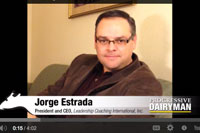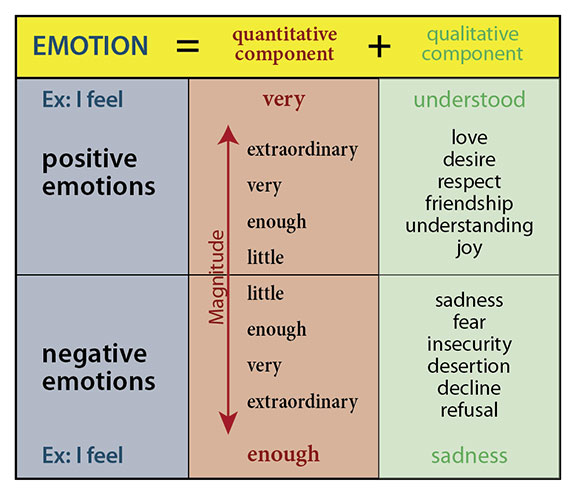It is 10 a.m. on a November morning in 1981. A 15-year-old boy is standing across the desk from his dad at his dad’s cardboard factory. The dad is screaming and complaining, pointing out who knows what. And then he comes down on the young boy, telling him he can’t do anything right.
Why did you do it this way or that way? In the end it really doesn’t matter what the dad was yelling about. It is not the first time he does it – or the last time. Tears fall down the boy’s cheeks and his mouth gets tight and wet.
The emotions he is experiencing are overwhelming. He is afraid as this deep voice comes down on him. He is sad because he can’t understand why someone who supposedly loves him is treating him like this.
This boy is me 32 years ago, at my dad’s factory where I worked part-time during school breaks. I can tell you it wasn’t until years later that I learned to recognize what I might have been feeling back then.
It is almost as if I was numbed by those situations occurring over and over again. I can also tell you that I have that memory engraved in my brain and my soul. It is as if it happened yesterday.
 Click here to view a related video of Jorge Estrada discussing this topic.
Click here to view a related video of Jorge Estrada discussing this topic.
Medical research is finding out how the cells in our bodies, through the receptors on the cell surface and through the proteins that carry messages across the cell wall into and out of the cell, also have a sensitivity to the emotions we feel.
We might say that the stronger the emotions, the more the cells in our bodies are bathed with the emotions we feel. That is great if you are feeling love and happiness. But what if you are feeling deep anger, fear or sadness?
As we continue to explore the most effective ways of leading, we must feel and know the five fundamental emotions and work with them to increase our leadership effectiveness. When I say work with them, I mean recognize them in us, express them as needed and manage them.
Because you lead a group of people or an entire organization, you must also learn to recognize them in other people. Let’s review each of them, for which I provide a briefing – and reflection questions for those willing to do deeper work.
Love
“Lead with love,” says Ken Blanchard in his recent book. I imagine you do love what you do. Your passion and energy about dairying comes through in many of the ways in which you work because you love the game you are playing.

I love doing what I do because I get a chance to apply my talents and skills every day. But besides loving our vocations, I am talking about love in a deeper emotional sense.
The word love can refer to a variety of different feelings, states and attitudes – ranging from pleasure to interpersonal attraction.
It can refer to an emotion of strong affection and personal attachment. It can also be a virtue representing human kindness, compassion and affection – the unselfish loyal and benevolent concern for the good of another.
And it may describe compassionate and affectionate actions towards other humans, one’s self or animals.
When you come from the background you came from, where did you learn this one? Where and when did you see it at home? When was the first time you fell in love?
Self-reflection: When was the last time you felt it (love)? How did you learn to fully express it? How do you currently express it, or manage the lack or excess of it?
Happiness
The sense of joy, a smile, a laugh. All I want is to be happy, you might say. Don’t we all? Yet some people live their lives as if happiness is at the end of their journey – after they get the next promotion, after they double their herd size, after retiring. In the meantime, life passes by.
Contrary to that belief are the people who “slow down and smell the roses” – people who see happiness in the littlest things, people who create experiences for themselves where happiness just evolves in the moment and they are able to feel it.
Their faces shine. They have an energy that is contagious. What experiences are currently creating happiness in your life?
Self-reflection: When was the first and last time you felt it? How did you learn to fully express it? How do you currently express it, or manage the lack or excess of it?
Of the five emotions, we could look at love and happiness being generally positive emotions.
Sadness
Sadness is a severe pain related to sorrow – feeling alone and helpless – which results from negative outcomes. I remember when my cousin Rodrigo died in a car accident. He was 28 years old. He loved cows and had started a nice dairy down in Guatemala.
Deep sorrow and sadness came upon my family. But it doesn’t have to be something that extreme to cause you to be sad. Missing a person in your life, seeing a cow die, the hardships of the ups and downs in the industry, a strained relationship – all of these could trigger you to become sad.
When was the last time you cried? I bet you felt a cleansing action. But we in agriculture are supposed to be tough, right? It is a belief deeply ingrained in our beings.
Self-reflection: When was the first and last time you felt it? How did you learn to fully express it? How do you currently express it, or manage the lack or excess of it?
Fear
Fear is an emotion induced by a perceived threat which causes entities to quickly pull away and usually hide. It is a basic survival mechanism occurring in response to a specific stimulus, such as pain or the threat of danger.
The personal situation I described at the beginning of the article is a great example, but you don’t have to be a kid to be afraid. Fear is a natural emotion – you feel it, I feel it, the president probably feels it – and I wonder if the new pope fears anything.
The dairy market, the future, so much change around us, uncertainty ahead, all of which can bring fear. Similar to sadness, fear is an emotion those of us involved in agriculture may have learned to suppress. Man up, don’t be afraid. This is easier said than done.
Self-reflection: When was the first and last time you felt it? How did you learn to fully express it? How do you currently express it, or manage the lack or excess of it?
Anger
Anger is an emotion related to one’s psychological interpretation of having been offended, wronged or denied, often followed by a tendency to react through retaliation. Anger has been described as a normal emotion that involves a strong uncomfortable and emotional response to a perceived provocation.
The thing with anger is that a strained relationship, a divorce, a failed business deal or the market itself might cause us to be angry, and we sometimes carry that anger for a long time.
I must admit I was angry with my father for a long time for what happened when I was a kid. Through therapy and some coaching, I have moved forward and evolved from that space.
Self-reflection: When was the first and last time you felt it? How did you learn to fully express it? How do you currently express it, or manage the lack or excess of it?
Of the five emotions, we could look at sadness, fear and anger as the negative emotions. One of the challenges with emotions, particularly the negative ones, is when we bottle them up and can’t find effective ways of expressing them.
In a recent coaching conversation with the general manager of a feedyard, he said, “I feel trapped,” as we discussed anger that has lingered in his life since an early age.
The following figure illustrates a framework to use in order to help us better understand and communicate our own and others’ emotions.
As I teach, facilitate and coach executives, managers and supervisors all around the country, I say that the ultimate goal of communication is to connect with each other – to create a deeper understanding of each other so that trust might evolve in our relationships.
This is an essential component in helping create the best work possible for ourselves and the best working environments in our companies.
In conclusion, I don’t need to tell you that emotions are a fundamental component of who we are. However, the key is whether you have the leadership skill necessary to identify your own emotions and those of others – and know what to do with them. PD

Jorge Estrada
President and CEO
Leadershipship Coaching International Inc.






